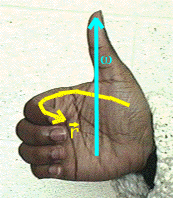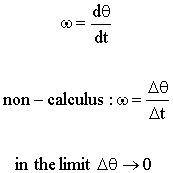

 Again,
in analogy to linear motion, in which the velocity
vector was defined as v = dx/dt (or
Again,
in analogy to linear motion, in which the velocity
vector was defined as v = dx/dt (or

To be precise,
If the axis of rotation is along the thumb, and the object rotates in the direction the fingers are pointing, then the angular velocity vector points in the same direction as the thumb.
We obtain the average angular velocity for finite time intervals just as we introduced the average velocity earlier:
Special case:
If the angular velocity is constant and the initial angle
© MultiMedia Physics, 1999